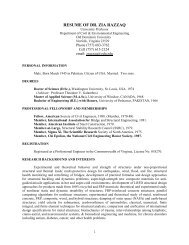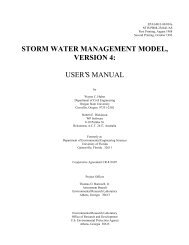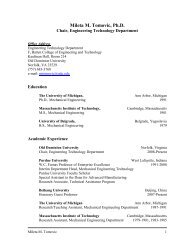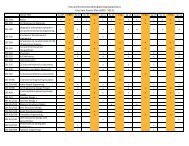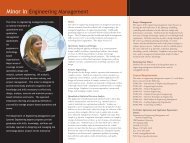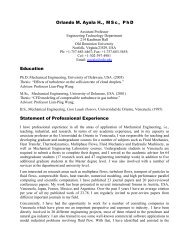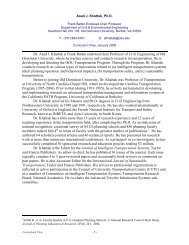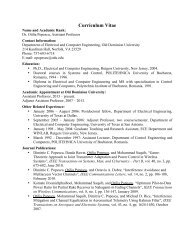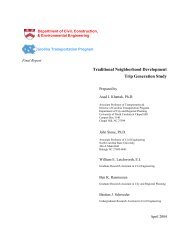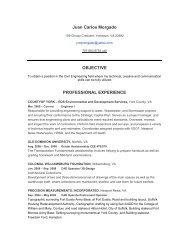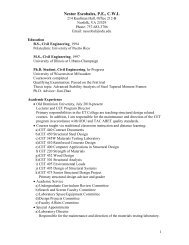ARTICLE IN PRESS6 G. Comert, M. Cetin / European Journal of Operational Research xxx (2008) xxx–xxxTable 1Two-sigma deviations at various p levelsp 0.0001 0.1 0.2 0.3 0.4 0.5 0.6 0.7 0.8 0.9 0.9999# of <strong>vehicle</strong> (2r) 8.5 6.6 5.1 4.1 3.3 2.6 2.1 1.5 1.1 0.7 0.0Dev. % (2r) 75 58 45 36 29 23 18 13 10 6 05. Analysis with the overflow queueIn the previous section, the overflow queue (cycle to cycle overflow)or the residual queue at the end of green period is ignored. Inthis section, the total queue <strong>length</strong> <strong>estimation</strong> that also includesthe overflow queue due to randomness is presented. It is still assumedthat average demand is less than the capacity – undersaturatedconditions. Let N o be the overflow queue <strong>length</strong> and N r be thequeue <strong>length</strong> that occurs <strong>from</strong> new arrivals during the red period.The total queue <strong>length</strong> to be estimated, N, is the summation of N oand N r . At any given cycle, <strong>probe</strong> <strong>vehicle</strong>s may or may not be presentin one or both of N o and N r , leading to four possible scenarios.Irrespective of where a <strong>probe</strong> <strong>vehicle</strong> is in the queue, the generalformulation and equations presented before are applicable as longas the marginal probability function, P(N = n), is known. Therefore,the analysis can be carried out without dealing with these scenariosindividually.The main input needed is the marginal probability of the totalqueue <strong>length</strong>, P(N = n). For a traffic light with fixed timing, someresearchers developed models that allow calculation of P(N = n)numerically. These models involve finding the complex roots ofthe pgf of overflow queue in equilibrium (Abate and Whitt,1992). The application of these models also requires numericalevaluation and approximations for pgf inversion (Van Leeuwaarden,2006). The second alternative to find P(N = n) is through simulation.In this paper, a simulation model is developed todetermine P(N = n).In this example, arrivals are assumed to be Poisson with a rateof k, and the <strong>vehicle</strong>s are assumed to depart <strong>from</strong> the stopbar at aconstant rate during the green, which is assumed to be 2 secondsper <strong>vehicle</strong>. Therefore, the service rate l is equal to the green durationdivided by 2. The total queue <strong>length</strong> is defined as N = N o + N r inequilibrium conditions. The distribution of total queue <strong>length</strong>,P(N = n), is determined by running the simulation multiple times.The traffic light parameters are chosen as follows: cycle <strong>length</strong>,C = 90 seconds; red period, r = 45 seconds; and green period,g = 45 seconds. The arrival rate, k, is set to 20 <strong>vehicle</strong>s per cycle.These selected parameters correspond to a v/c ratio of 0.89. Simulationis run for 180,000 seconds and replicated 1000 times. Thefirst 200-cycles in each replication is considered as the warm-upperiod and not included in calculating the equilibrium distributionof P(N = n).Once the P(N = n) is obtained, an analysis similar to the one presentedin the previous section can be performed to determine theTable 2Results for various q valuesp = 0.5q = k/l k Mean = E(N) r 2 = E(VAR(Njl p )) 2r Dev. (%)0.50 11.25 5.630 1.295 2.3 400.60 13.50 6.757 1.395 2.4 350.70 15.75 7.936 1.472 2.4 310.80 18.00 9.338 1.553 2.5 270.88 20.00 11.394 1.654 2.6 230.90 20.25 11.816 1.672 2.6 220.95 21.38 14.938 1.766 2.7 180.99 22.00 23.580 1.876 2.7 12100* σ/E(N)70605040302010λ/μ=0.6λ/μ=0.7λ/μ=0.8λ/μ=0.9λ/μ=0.9900 0.1 0.2 0.3 0.4 0.5 0.6 0.7 0.8 0.9 1Proportion of Probes, pFig. 10. Normalized errors versus proportion of <strong>probe</strong>s at different q values.expected total queue <strong>length</strong> and variance. For brevity, only the resultsthat show how error changes by the proportion of <strong>probe</strong> <strong>vehicle</strong>sare presented here. Fig. 9 shows the expected total queue<strong>length</strong> and one- and two-sigma deviations <strong>from</strong> the mean versusthe proportion of <strong>probe</strong>s, p. Compared to Fig. 6, the mean is shiftedupwards due to the effect of the overflow queue, and the deviationsshow similar behavior.The results presented in Fig. 9 are summarized in Table 1 to easilysee the improvement in errors when p gets larger. The 2 rdeviations are presented in two formats: as absolute values (row2) and as percentage of the mean (row 3). The values in row 3can also be interpreted as the coefficient of variance (cv) multipliedby two. It is useful to look at both absolute deviations in terms ofthe number of <strong>vehicle</strong>s and the percent deviations since the targeterror criterion can be expressed in both formats. For example, for80% <strong>probe</strong> <strong>vehicle</strong>s, the expected error is about 10% and the absoluteerror is about ±1 <strong>vehicle</strong>. If the error is assumed to follow anormal distribution then, these error rates roughly correspond toa 95% confidence interval.Thus far, the results presented are for a constant arrival ratewith a v/c ratio or q equal to 0.89. To understand the impact of qon accuracy, the arrival rate is varied to generate the scenariosshown in Table 2 where the percent of <strong>probe</strong> <strong>vehicle</strong>s p is kept constantat 50%. For each one of these scenarios, the simulation programis run separately to obtain P(N = n) and the equationsdescribed above are utilized to estimate the means and variances.The last two columns of Table 2 convey the same type of informationpresented in Table 1. As it can be observed, absolute deviations(2r) are not increasing significantly as v/c or q increases. On theother hand, percent deviations <strong>from</strong> the mean are decreasing substantiallywith increasing q.In order to depict a more comprehensive picture, Fig. 10 is createdto analyze the errors both as a function of <strong>probe</strong> proportions pand q = k/l values. The normalized percent error (or percent coefficientof variation) decreases with increasing proportion of <strong>probe</strong>sas expected. However, the errors at different q values show a complexbehavior as a function of p. For very small p values (less than5%) the relative error gets very large when q approaches 1. This canbe attributed to the increase in the size and variance of the initialqueue. For larger p values, the relative error is smaller for larger qvalues as also indicated in the results of Table 2.Please cite this article in press as: Comert, G., Cetin, M., <strong>Queue</strong> <strong>length</strong> <strong>estimation</strong> <strong>from</strong> <strong>probe</strong> <strong>vehicle</strong> location and the impacts of samplesize, European Journal of Operational Research (2008), doi:10.1016/j.ejor.2008.06.024
ARTICLE IN PRESSG. Comert, M. Cetin / European Journal of Operational Research xxx (2008) xxx–xxx 76. ConclusionsThis paper presents a statistical method for real-time <strong>estimation</strong>of queue <strong>length</strong> at a signalized intersection approach <strong>from</strong><strong>probe</strong> <strong>vehicle</strong> data under the assumption that the marginal probabilitydistribution of the queue <strong>length</strong> P(N = n) is known. Analyticalexpressions are derived for queue <strong>length</strong> <strong>estimation</strong> and for erroranalysis where the queue <strong>length</strong> is estimated based on the positionor location of <strong>probe</strong> <strong>vehicle</strong>s in the queue. It is found that, in termsof real-time data, only location of the last <strong>probe</strong> <strong>vehicle</strong> l p in thequeue is sufficient for the <strong>estimation</strong> (i.e., location of other <strong>probe</strong>sor the total number of <strong>probe</strong> <strong>vehicle</strong>s in the queue are redundant).Therefore, <strong>from</strong> the technological perspective, tracking only thelocation of the last <strong>probe</strong> in the queue is sufficient. Obviously, thisconclusion is valid for the conditions and assumptions consideredin the paper (e.g., steady-state conditions, known arrival rate). Forexample, any information on the arrival times of <strong>probe</strong> <strong>vehicle</strong>s isnot considered here, which can potentially provide additional benefitsto the queue <strong>length</strong> <strong>estimation</strong>.Exact expressions for the conditional mean and variance of thequeue <strong>length</strong> for a given l p are derived. Two example applicationsare presented for a traffic light with fixed timing where arrivals areassumed to follow a Poisson distribution. In the first example,overflow queue is not considered and therefore the probability distributionof the queue <strong>length</strong> becomes Poisson. In the secondexample, overflow queue is considered and P(N = n) is derived <strong>from</strong>simulated data since there is no readily available analytical modelto determine P(N = n). For both of these examples, the relationshipbetween the percentage of <strong>probe</strong> <strong>vehicle</strong>s p and the accuracy of theestimates is analyzed. Obviously, as p increases error diminishes.The results can be used to select an appropriate p for given confidencelevel and error level. In addition, it is found that as volumeto capacity or q increases, the absolute error in the queue <strong>length</strong>estimates does not increase significantly whereas the percentageerror relative to the mean decreases significantly for p values largerthan 10%. This implies that queue <strong>length</strong>s can be estimated moreeffectively at relatively high volumes. It should be noted that theseresults are obtained for undersaturated conditions (q < 1.0).This paper presents what appears to be the first attempt to formulatethe problem of estimating the queue <strong>length</strong> <strong>from</strong> <strong>probe</strong><strong>vehicle</strong> data. The presented formulation relies on a priori knowledgeof the marginal distribution of N. Therefore, specifying anaccurate distribution for N is an important issue. There are numerousopportunities for future research. Extensions that deal withtime dependent demand, multiple intersections, actuated signals,and oversaturated conditions are some obvious ones. In addition,the use of other types of <strong>probe</strong> <strong>vehicle</strong> data, beyond the <strong>probe</strong> <strong>vehicle</strong>location, should also be investigated.AcknowledgementsThe authors wish to thank the University of South Carolina forsupporting this research. The authors are also grateful to the anonymousreviewers who provided very detailed and insightful commentsthat helped us improve the quality of this manuscript.ReferencesAbate, J., Whitt, W., 1992. Numerical inversion of probability generating functions.Operations Research Letters 12, 245–251.Banks, J., Carson II, J.S., Nelson, B.L., Nicol, D.M., 2001. Discrete-Event SystemSimulation. Prentice-Hall, New Jersey.Boyce, D.E., Hicks, J., Sen, A., 1991. In-<strong>vehicle</strong> navigation requirements formonitoring link travel times in a dynamic route guidance system. OperationsReview 8 (1), 17–24.Cetin, M., List, G.F., Zhou, Y., 2005. Factors affecting the minimum number of <strong>probe</strong>srequired for reliable travel time <strong>estimation</strong>. Transportation Research Record1917, 37–44.Chen, M., Chien, S.I.J., 2000. Determining the number of <strong>probe</strong> <strong>vehicle</strong>s for freewaytravel time <strong>estimation</strong> by microscopic simulation. Transportation ResearchRecord 1719, 61–68.Cheu, R.L., Xie, C., Lee, D., 2002. Probe <strong>vehicle</strong> population and sample size for arterialspeed <strong>estimation</strong>. Computer-Aided Civil and Infrastructure Engineering 17 (1),53–60.Darroch, J.N., 1964. On the traffic-light queue. The Annals of MathematicalStatistics, 380–388.Duffield, N.G., 2006. Network tomography of binary network performancecharacteristics. IEEE Transactions on Information Theory 52, 5373–5388.Ferman, M.A., Blumenfeld, D.E., Dai, X., 2005. An analytical evaluation of a real-timetraffic information system using <strong>probe</strong> <strong>vehicle</strong>s. Journal of IntelligentTransportation Systems: Technology, Planning, and Operations 9 (1), 23–34.Gartner, N.H., Pooran, F.J., Andrews, C.M., 2002. Optimized policies for adaptivecontrol systems: Implementation and field testing. Transportation ResearchRecord 1811, 148–156.Haight, F.A., 1959. Overflow at a traffic flow. Biometrika 46 (3-4), 420–424.Heidemann, D., 1994. <strong>Queue</strong> <strong>length</strong> and delay distributions at signalizedintersections. Transportation Research Part B 28 (5), 624–635.Hellinga, B.R., 2002. Improving freeway speed estimates <strong>from</strong> single-loop detectors.Journal of Transportation Engineering 128 (1), 58–67.Lin, I., Rong, H., Kornhauser, A.L., 2008. Estimating nationwide link speeddistribution using <strong>probe</strong> position data. Journal of Intelligent TransportationSystems 12 (1), 29–37.McNeil, D.R., 1968. A solution to the fixed cycle traffic light problem for compoundPoisson arrivals. Journal of Applied Probability 5, 624–635.Miller, A.J., 1963. Settings for fixed-cycle traffic signals. Operations ResearchQuarterly 14, 373–386.Mung, K.S.G., Poon, A.C.K., Lam, W.H.K., 1996. Distributions of queue <strong>length</strong>s at fixedtime traffic signals. Transportation Research Part B 30 (6), 421–439.Newell, G.F., 1965. Approximation methods for queues with application to thefixed-cycle traffic light. SIAM Review 7, 223–240.Olszewski, P., 1990. Modeling of queue probability distribution at traffic signals. In:Koshi, M. (Ed.), Transportation and Traffic Theory. Elsevier, Amsterdam, pp.569–588.Rouphail, N., Tarko, A., Li, J., 2001. Traffic flows at signalized intersections. TrafficFlow Theory Monograph.Srinivasan, K.K., Jovanis, P.P., 1996. Determination of number of <strong>probe</strong> <strong>vehicle</strong>srequired for reliable travel time measurement in urban network. TransportationResearch Record 1537, 5–22.Turner, S., Holdener, D., 1995. Probe <strong>vehicle</strong> sample sizes for real-time information:The Houston experience. In: Proceedings of the Vehicle Navigation &Information Systems Conference, Seattle, WA, United States, pp. 3–10.USDOT, 2008. Nationwide Differential Global Positioning System Program FactSheet, Turner-Fairbank Highway Research Center. , visited on February 26.Van Leeuwaarden, V.J.S.H., 2006. Delay analysis for the fixed-cycle traffic-lightqueue. Transportation Science 40 (2), 189–199.Van Zuylen, H.J., Viti, F., 2007. A probabilistic model for queues, delays and waitingtime at controlled intersections. In: 86th Annual Meeting of the TransportationResearch Board CD-ROM.Webster, F.V., 1958. Traffic signal settings. Road Research Laboratory TechnicalPaper No. 39, HMSO, London.Xi, B., Michalidis, G., Nair, V.N., 2006. Estimating network loss rates using activetomography. Journal of the American Statistical Association 101 (476), 1430–1448.Please cite this article in press as: Comert, G., Cetin, M., <strong>Queue</strong> <strong>length</strong> <strong>estimation</strong> <strong>from</strong> <strong>probe</strong> <strong>vehicle</strong> location and the impacts of samplesize, European Journal of Operational Research (2008), doi:10.1016/j.ejor.2008.06.024



